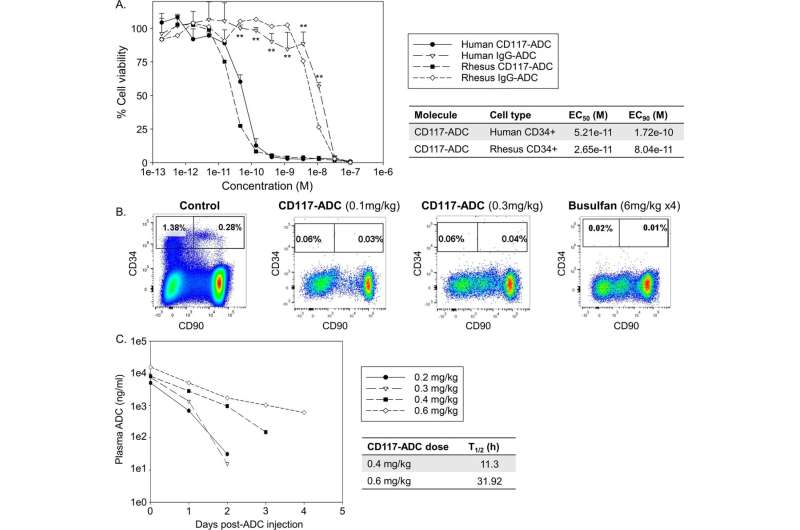CD117-ADC depletes both human and non-human primate CD34+ cells. A Escalating doses of CD117-ADC were added to primary human and rhesus CD34+ cells in culture, and cell viability at day 6 was evaluated to calculate the half maximal effective concentration (EC50) for killing (n = 3 biologically independent human donors, n = 2 biologically independent rhesus donors). Data are presented as mean +/− standard deviation. The standard deviation was shown as error bar. **p < 0.01 evaluated by one-tailed student’s t-test for human CD34+ cells. p = 1.72e−1, 2.47e−1, 7.29x−2, 9.96e−2, 8.26e−2, 1.31e−4, 5.81e−6, 9.63e−6, 1.78e−4, 3.60e−5, 3.37e−6, 2.89e−1, and 2.98e−1, respectively (from the lower concentration). B Cynomolgus macaques were treated with intravenous injection of CD117-ADC (0.1 or 0.3 mg/kg × 1 day, n = 3 per dose) or busulfan (6 mg/kg × 4 days, n = 3), and bone marrow CD34 + CD90 + CD45RA- cells were quantified by flow cytometry 7 days after drug administration (n = 3). C To evaluate drug clearance, plasma concentrations of ADC in the circulation were measured after a single intravenous injection of CD117-ADC (0.2, 0.3, 0.4, and 0.6 mg/kg) in rhesus macaques (n = 1). The ADC concentrations for 0.2 and 0.3 mg/kg at day 3, and 0.2, 0.3, and 0.4 mg/kg at day 4 were below the limit of quantification. IgG-ADC: immunoglobulin G isotype control-conjugated ADC. Source data are provided as a Source Data file.
Researchers at the National Institutes of Health have created a novel gene therapy procedure that could preserve fertility in people with sickle cell disease and other genetic blood conditions. Infertility is a high-risk and long-term side effect associated with current bone marrow transplantation and gene therapy approaches to treat sickle cell disease. It is a common reason people of reproductive age give for not pursuing these therapies.
The study, which appears in Nature Communications, describes the successful testing in animals of an antibody-drug conjugate, or conditioning agent, that exclusively targets blood-forming stem cells in the bone marrow. Conditioning agents are used in gene therapy to remove diseased stem cells and allow healthy stem cells to form.
This new agent, called CD117-ADC, does not appear to damage other organs during the conditioning process. It is less toxic than the conventional agent now used for gene therapy in humans, called busulfan, which may cause ovarian failure in women and may stop sperm production in men, resulting in infertility.
Researchers found that CD117-ADC allowed robust engraftment of gene-modified cells to increase fetal hemoglobin, a type of oxygen-carrying blood protein present at birth. When used in adults with sickle cell disease, fetal hemoglobin can reduce complications associated with the disease, and reactivating and increasing its production is a promising goal for gene therapy. Unlike busulfan, the new conditioning agent also was shown to preserve fertility in females and males.
More information: Naoya Uchida et al, Fertility-preserving myeloablative conditioning using single-dose CD117 antibody-drug conjugate in a rhesus gene therapy model, Nature Communications (2023). DOI: 10.1038/s41467-023-41153-5
Journal information: Nature Communications
Provided by National Institutes of Health
























